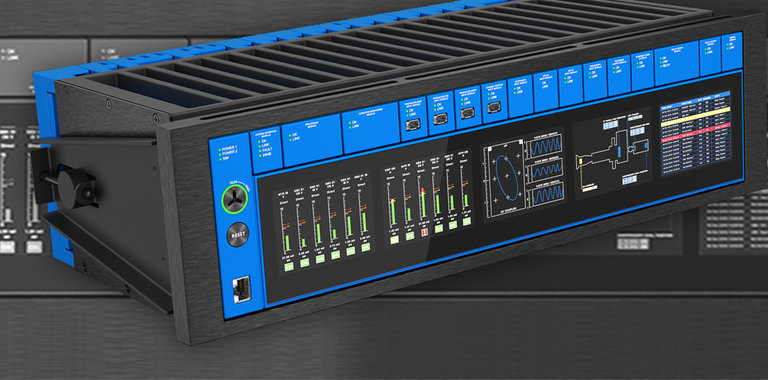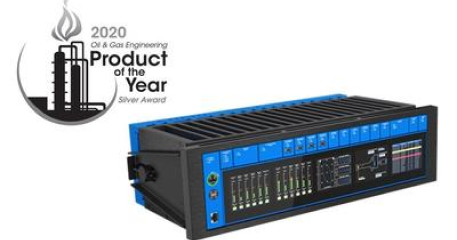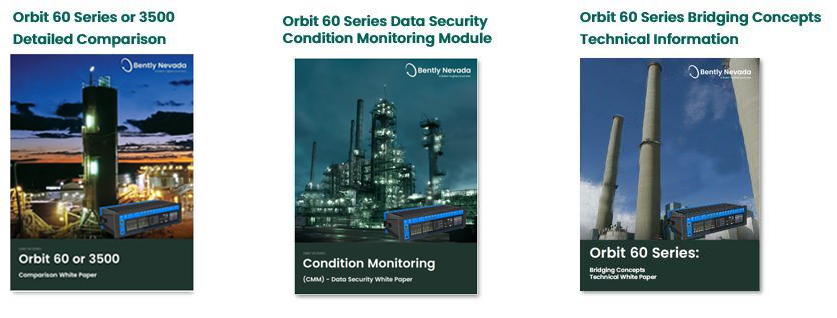
Orbit 60 Series Update: New Features with Our Latest Release
Introduction
Welcome to our 10th article focused on Orbit 60 and Orbit 60 enabled enhancements. In this article, we’d like to let you know that we are very pleased with our new product. All of our past articles have given you some insight into why we are so proud of what we have been able to design and build. Similar to all of our major monitoring line products, 7200, 3300 & 3500, we are only able to introduce certain functionality initially, and then build on that foundation. Our first release, which has been successfully installed in multiple locations was what we call our API 670 release. This article will focus on our second release which is due out roughly at the same time as this article.
Our past articles have focused on the cyber security, hardware, configuration and System 1 aspects of the system, you may follow the links below to access them:
- Q1 2020 Orbit Article - Introducing Orbit 60
- Q2 2020 Orbit Article - Available to Quote - Explore the Cost Savings
- Q3 2020 Orbit Article - Now - Less Spares!! - How to Choose Input Modules
- Q4 2020 Orbit Article - System Fundamentals - Output Cards
- Q1 2021 Orbit Article - Cyber Secure Condition Monitoring!
- Q2 2021 Orbit Article - Orbit Studio Configuration Software
- Q3 2021 Orbit Article - API 670
- Q4 2021 Orbit Article - Dispelling the rumors - 3500 is NOT obsolete!
API 670 Edition:
Just a quick recap of our first, introductory phase, product. In our first release, we wanted to ensure that we met API 670 monitoring standards including hot swappable cards, sensor fault detection, and the avoidance of single points of failures compromising the system. The API 670 release included these core hardware features:
- 3U (height), 20 slot chassis
- Accepted sensors:
- Proximitors
- Radial X-Y
- Axial position
- Keyphasor®
- High Speed (up to 120,000 RPM)
- Accelerometers
- Velomitors
- Temperatures
- Discrete Inputs
- Proximitors
- Relays
- Modbus Communications
- Remote Displays
- 3200 lines of resolution
- Core Combustion Monitoring
- State Based Monitoring (Alarms values based upon operating state)
- IEC 62443-4-2 Cyber design (for more information, please see our Q1, 2021 Article)
- Core Product Certifications
So, as you can see, we accomplished a very impressive list of features with the first release. Our second release, 22.1, is even more ambitious, and is geared towards our customers with large steam turbine generators. These machines require Turbine Supervisory Instrumentation, or TSI, to make sure that they are operated safely. Along with the TSI capabilities, we also planned in a few more features as well.
22.1 – Turbine Supervisory Instrumentation (TSI) edition
From a hardware perspective, Turbine Supervisory instrumentation includes being able to take in input from sensors such as AC LVDT’s for reading valve position and/or case expansion, moving coil velocity sensors for older style absolute measurements and process variable signals (4-20 mA, 1-5 VDC, 0-10 VDC). These measurements (and more) are accommodated through the following new input cards:
- PAS –This card is the only card that accepts moving coil velocity sensors, which historically have been used with proximity probes to develop a shaft absolute value. In most modern instances, the moving coil sensors have been replaced with solid state velomitors. In addition to the moving coil sensors, this card can also take in proximity probes and accelerometers.
- AC LVDT – as its name implies, this card allows up to four AC LVDTs in either 4, 5 or 6 wire configurations. These measurements are most often used for case expansion or valve position measurements. DC LVDT’s, which are uncommon, use the PAD input card, which will be available later.
- PVT – Positive Voltage Transducers. While this card can take input from proximity and velomitor sensors, it was specifically designed to be compatible with most industrial accelerometers. These accels are typically powered with a positive voltage, whereas our monitors have traditionally provided a negatively biased power. The PVT will standardize these measurements and will not require a phase correction. We foresee this card helping you monitor your ancillary machines that utilize Rolling Element Bearings.
- PVD – Process Variable and Discrete Inputs. Much like the PVT card above, this new card is not TSI specific either. The PVD card allows us to take in 4-20 mA, 0-10VDC or 1-5VDC signals (actually any voltage between +10 and -10 VDC), as well as Dry or Wet contacts.
- PAD – This input card is very similar to the PAV card introduced in the original release. While the PAD can bring in negatively biased sensor such as proximity probes, 3-wire accels, 330500 Dynamic Pressure sensors, 350501 accelerometers, and proximity based Keyphasors, it is the sole card that can bring in DC LVDT’s, which are of course, of great importance to TSI installations.
- 6U Chassis – This double height chassis (same height as a standard 3500 rack) is able to accommodate 29 slots, or 10 more than our 3U chassis. Since most machine trains that require TSI functionality have many bearings (typically up to a dozen), having extra slots cuts down on the need for multiple racks.
Part of our core Orbit 60 design philosophy is to design full capabilities into the hardware, and then turn them on later with firmware and software upgrades as they become available. To this end, this second phase has enabled us to enhance Orbit 60’s capabilities with the following firmware enhancements:
- Case, Differential Expansion and Valve Position Measurements – These are some key TSI related measurements. With the addition of the hardware noted above, our new PPM, Protection Processor Module, firmware can process and provide values for Case differential Expansion and valve position measurements like those available on a 3500/45 monitor.
- Shaft Absolute Measurements – These measurements have long been a standard for large steam turbines and have been available all the way back to our 7200 monitoring systems. They are generated by summing the shaft relative (proximity probe) and Casing Absolute (Velocity integrated to displacement) measurements to develop Shaft absolute. There are multiple papers available that discuss this measurement type, and its associated design considerations.
- Acceleration Enveloping – This sampling methodology is specifically geared (pun not intended) towards Rolling Element (Anti-Friction Bearings). This is a new trended variable available in System 1® for accelerometers.
- Amplitude Extraction – Amplitude extraction is another new trended variable In System 1® made possible by Orbit 60. Amplitude extraction is an efficient way of using spectral data to quantify the amount of energy around a center frequency, given a user defined bandwidth.
- EGD Communications – This communication protocol is largely used with General Electric control systems such as the Mark V or VI.
- Zero Speed – Again, another standard TSI function. If a large steam turbine rotor is allowed to sit still, it starts to sag or bow. This could make for a very rough startup. Zero speed allows an operator to engage the turning gear or alerts them to a stopped condition.
- Eccentricity – Along with zero speed, eccentricity provides information on the amount of bow the rotor has incurred. Typically, an operator will consult the eccentricity measurement prior to starting the turbine up. If eccentricity is too high, the unit should remain on turning gear until it is safe to start.
- Relay Reflash – This feature allows an operator to acknowledge an alarm without clearing it. If another, separate, alarm comes in, the reflash will deactivate the relay briefly, and when it is reactivated it will cause the annunciation to blink. This keeps operations informed of the current condition, even if a point has been in alarm for a period of time.
CSA Certification
Last but certainly not least, Orbit 60 has earned its CSA certification. Pandemic related personnel shortages affected many diverse industries including the certification industry. As a result, the certification process took longer than expected. If your facility requires a paper certificate, expect these to be available shortly.
Wrapping Up
As a business, we are beyond excited by the release of the TSI version of Orbit 60, and exceptionally proud of our accomplishments. Since the launch of Orbit 60 we have shipped 65+ systems with at least 20 of them installed and operational. Additionally, we have received 160+ orders for new systems. As can be seen by our new TSI features, we have designed Orbit 60 to have the capability of adding additional functionality over time without having to add new hardware. This provides you, our partner in this business, enhanced value for your investment.
Look for even greater functionality in our planned future releases. Our next big push will be on releasing API 618 reciprocating compressor functionality (and the ubiquitous – “and, MORE”).
More information is available on our website:
Next Steps
Our teams are excited to discuss Orbit 60 in more detail. We have multiple technical white papers available for a deeper dive into the following topics. Please reach out through the contact us link below to receive a copy and we will connect you with your local expert.
- Orbit 60 Series or 3500 Detailed Comparison - This document details the difference between Bently Nevada's Orbit 60 Series machinery protection system and the 3500 system.
- Orbit 60 Data Security Condition Monitoring Module - This document is intended to describe how the Condition Monitoring Module in the Orbit 60 Series Monitoring System provides a secure solution with full high-resolution data to external networks without jeopardizing the operation of the protection functions.
- Orbit 60 Series Bridging Concepts - Bently Nevada introduces the concept of bridging with the Orbit 60 Series system architecture.
- Coming Soon: Protection Schemes & 3500 Retrofit White Papers
Learn more about Orbit 60
Product Video - Orbit 60 Teaser
Product Video - Orbit 60 Full length
Orbit 60 Series and System 1: Bloomberg TV:
Houston Chronicle: Bently unveils the Orbit 60
Turbo Machinery Magazine - Bently Nevada's New Platform
Q1 2020 Orbit Article - Introducing Orbit 60
Q2 2020 Orbit Article – Available to Quote – Explore the Cost Savings
Q3 2020 Orbit Article – Now – Less Spares!! – How to Choose Input Modules
Our Experts

John Kingham
Strategic Field Application Engineer
BIO
Mr. Kingham has been involved in the rotating machinery realm for more than 35 years. He started with Bently Nevada in 1986 as a Machinery Diagnostics Engineer, where he diagnosed machinery problems based upon their vibration characteristics.




